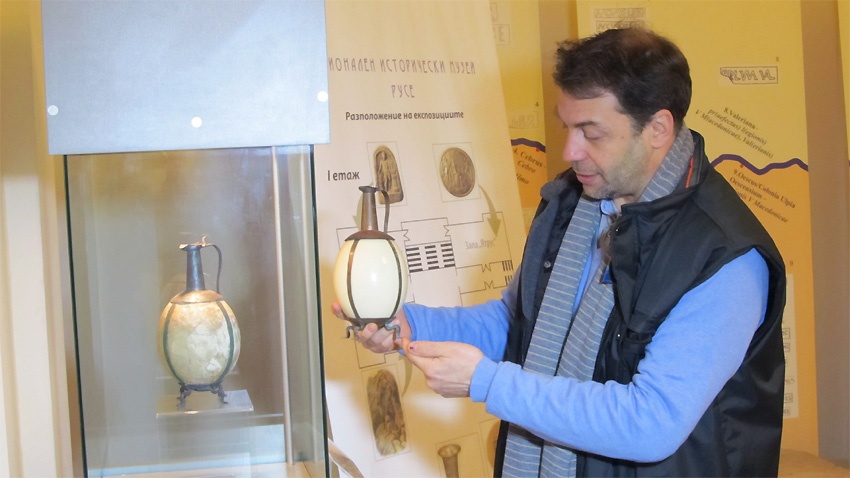Once upon a time or actually some 2500 years ago Thracians lived in the lands of present-day northeastern Bulgaria. One of the chiefs of the local tribes received a gift from distant lands. It was a beautiful pitcher to be used in ritual practices. The unique jug was made of ostrich egg. Unfortunately, the pitcher was broken in multiple pieces over time the Regional History Museum in Rousse received them as a donation. The museum staff realized the uniqueness of the donation half a year after it arrived.
“We knew this was some type of a vessel, museum director Associate Professor Dr. Nikolay Nenov says. “Only after the work of restorers finished we realized it was an extraordinary, magical object. It is abundantly clear that this is a ritual Thracian vessel dating back to the antiquity. At that time such a jug was just too exotic in our lands. We were wondering about the source of this Ostrich egg. We have also been looking for similar findings but there is no analogue discovered so far in the world. The British Museum has two ostrich eggs in its collection dating back to the VII-VI century BC. They are said to come from the east coast of the Mediterranean Sea - Phoenicia. Of course, we know about the ancient trade routes, coin circulation and manufacturers of certain products. Therefore, we can say that at that time the Getae Thracian tribe used to have trade relations with that part of the world. It is possible that the jug came to the lands of today’s Bulgaria in the 6th century BC.”
The museum director says that the expensive jug was probably used for containing wine during rituals.
 “Metal parts of the pitcher were made of bronze, very well preserved. Two of the legs needed to be made anew,” says Associate Prof. Nenov. The bronze left marks on the shell of the egg itself, which helped restoring the original shape. Currently the jug is in perfect condition.”
“Metal parts of the pitcher were made of bronze, very well preserved. Two of the legs needed to be made anew,” says Associate Prof. Nenov. The bronze left marks on the shell of the egg itself, which helped restoring the original shape. Currently the jug is in perfect condition.”
In the same way the jug was recovered from ostrich egg pieces the museum experts are looking for pieces of information in order to complete the story of the latest addition to the museum’s collection.
“Recently a lady came to our museum. She is a student in St. Petersburg and her lecturer works in the Hermitage. She also works there and according to her nothing similar can be seen. I hope that the experts there discover some information about a similar object as this is helpful to us”, Prof. Nenov concludes.
The museum has made a copy of the unique jug, also from an ostrich egg. It will be used during students’ classes held in the museum.
English version: Alexander Markov
The introduction of the subject "Virtues and Religions" in schools is not aimed at indoctrinating children, but at informing and educating them. Faith is something personal, Patriarch Daniil said in an interview for public service TV BNT. “Faith is..
On the second day after Easter begins Bright Week. It is so called because of the light that Christ's Resurrection brings to the world. According to Orthodox tradition, it is a time when the Holy Apostles and the Virgin Mary are glorified. Bright Week..
Patriarch Daniil celebrated a divine service for the so-called Second Resurrection of Christ in the Sofia-based church of Saint Nedelya. Patriarch Daniil greets Bulgarians with “Christ is Risen” At the festive liturgy, texts from the Gospel..

+359 2 9336 661
